Motorized Hurricane Screen
Why Maxforce

MAXFORCE PROVEN PROTECT
Engineered For Excellence
For nearly two decades, MaxForce has manufactured hurricane screens to meet the most demanding building code, the High Velocity Hurricane Zone of Miami-Dade. The MaxForce track is our newest version of the fixed track we have used with great success for high wind applications all over the globe.
The benefits of a fixed track are unmatched strength - this is important when designing a screen system for hurricanes. When you want the strongest system available, and a proven veteran of many hurricanes, the MaxForce Hurricane Track is your best choice.
MAXFORCE THE #1 MOTORIZED HURRICANE SCREEN
Contact A+ Certified MaxForce Screen Dealer Today...
MAXFORCE HURRICANE SCREENS
Engineering Features

No blowouts. No rewraps. No frustration.
MaxForce is the only retractable screen system on the market designed to stay locked in the track—even in high winds. Smart motor senses resistance and adjusts seamlessly, allowing self-correction when the screen encounters an obstacle: Fewer snags, fewer jams, and fewer costly service calls.
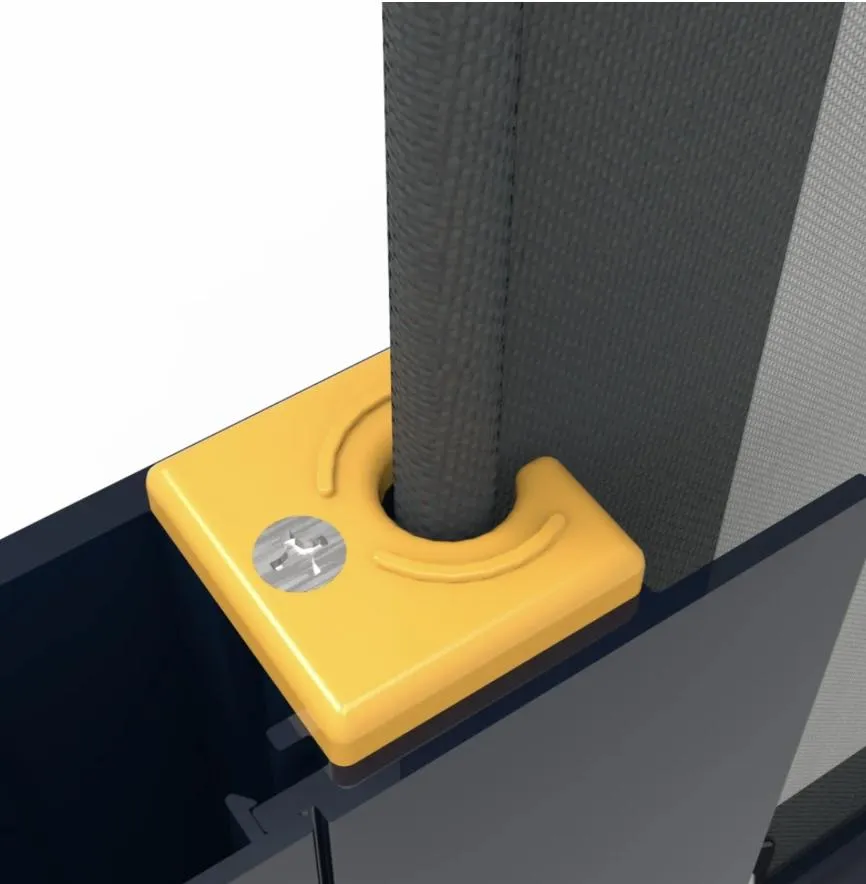
No Zipper. No Cable. Just Simple Deployment
MaxForce pioneered Keder-edge technology in motorized screens, delivering unmatched durability and simplicity. Borrowed from sailboat rigging, this system eliminates zippers, cables, and exposed hardware—ensuring smooth, reliable operation every time.
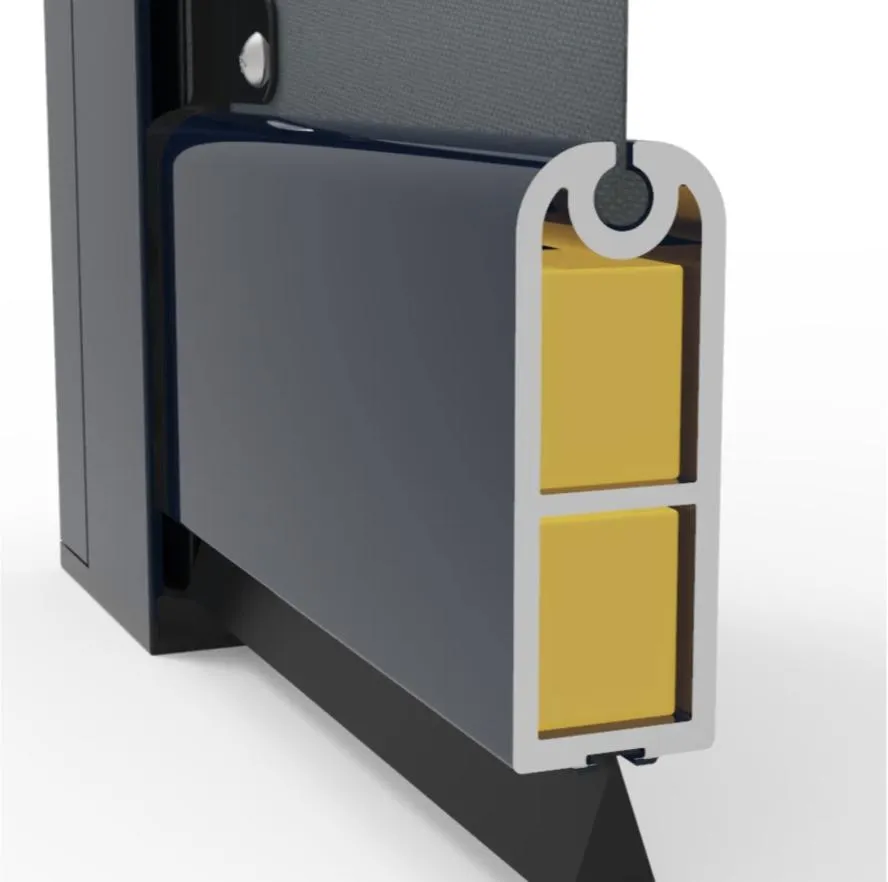
Heavy Duty
The MaxForce weight bar is engineered for strength—and built to hold its ground. Pound for pound, it’s the heaviest and most robust weight bar in the industry. This ensures proper screen tension, flawless deployment, and maximum stability in high wind zones. —limited flex, no failure.
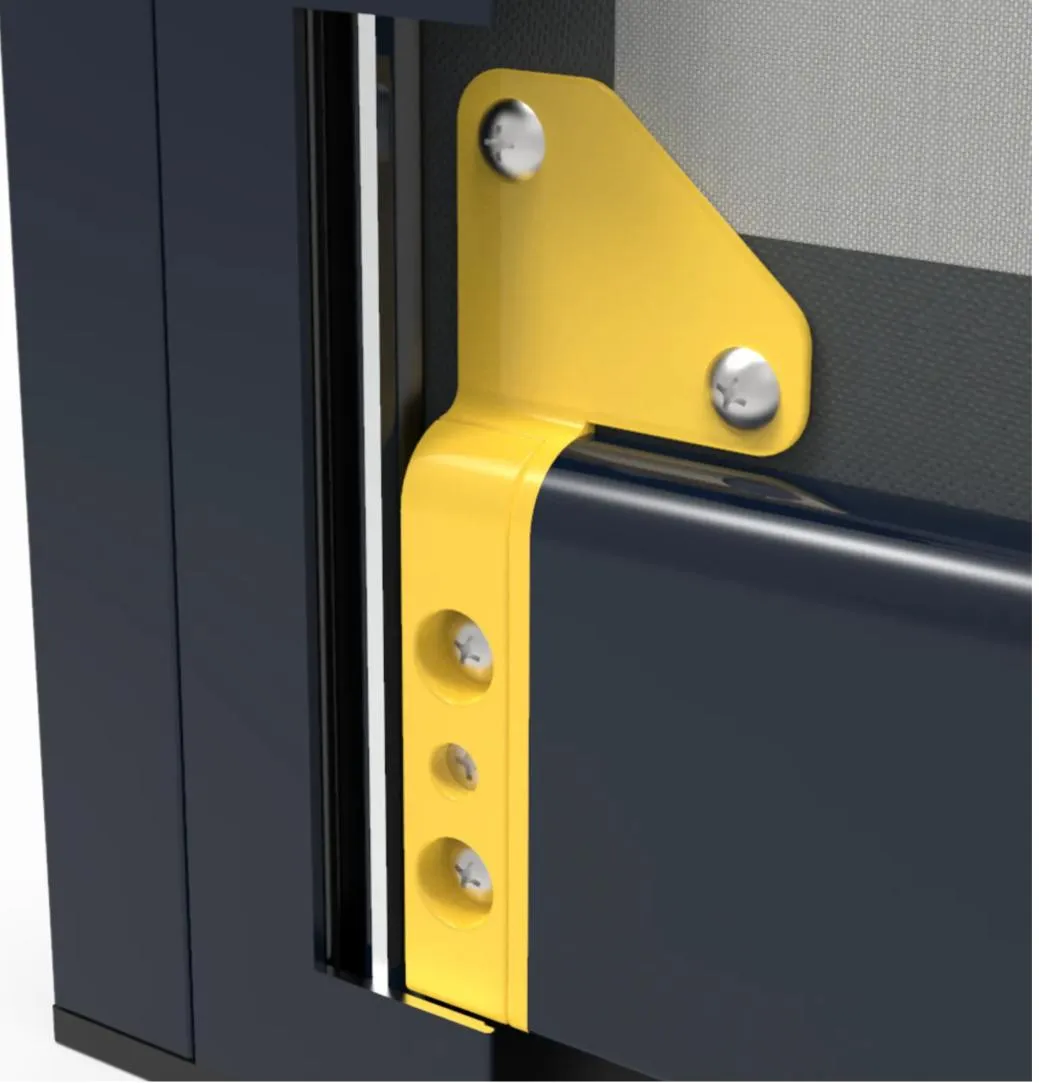
Reinforced Corners
MaxForce’s heavy-duty weight bar isn’t just strong. It’s smart. Reinforced corners and integrated tie-ins create a unified structure that acts like a solid wall of protection when deployed. Made from high-strength nylon, this bar absorbs impacts while maintaining structural integrity.
Motorized Hurricane Screen
Why Maxforce

MAXFORCE PROVEN PROTECT
Engineered For Excellence

For nearly two decades, MaxForce has manufactured hurricane screens to meet the most demanding building code, the High Velocity Hurricane Zone of Miami-Dade. The MaxForce track is our newest version of the fixed track we have used with great success for high wind applications all over the globe.
The benefits of a fixed track are unmatched strength - this is important when designing a screen system for hurricanes. When you want the strongest system available, and a proven veteran of many hurricanes, the MaxForce Hurricane Track is your best choice.
MAXFORCE THE #1 MOTORIZED
HURRICANE SCREEN
Contact A+ Certified MaxForce Screen
Dealer Today...
MAXFORCE HURRICANE SCREENS
Engineering Features

No blowouts. No rewraps.
No frustration.
MaxForce is the only retractable screen system on the market designed to stay locked in the track—even in high winds. Smart motor senses resistance and adjusts seamlessly, allowing self-correction when the screen encounters an obstacle: Fewer snags, fewer jams, and fewer costly service calls.

No Zipper. No Cable.
Just Simple Deployment
MaxForce pioneered Keder-edge technology in motorized screens, delivering unmatched durability and simplicity. Borrowed from sailboat rigging, this system eliminates zippers, cables, and exposed hardware—ensuring smooth, reliable operation every time.

Heavy Duty
The MaxForce weight bar is engineered for strength—and built to hold its ground. Pound for pound, it’s the heaviest and most robust weight bar in the industry. This ensures proper screen tension, flawless deployment, and maximum stability in high wind zones. —limited flex, no failure.

Reinforced Corners
MaxForce’s heavy-duty weight bar isn’t just strong. It’s smart. Reinforced corners and integrated tie-ins create a unified structure that acts like a solid wall of protection when deployed. Made from high-strength nylon, this bar absorbs impacts while maintaining structural integrity.

HEADACHE-FREE
Exclusive self-tensioning system eliminates 99.9% of screen issues. No track adjustments, broken zippers, or dislodged screens.

LIFETIME WARRANTY
Exterior shade screens reduce cooling bills and MaxForce hurricane screens reduce insurance premiums in hurricane zones.

HURRICANE STRONG
Our MaxForce tracks and advanced hybrid ballistic fabrics withstand 150+ mph winds. Approved by Florida Building Commission for hurricane zones. Lab and real-world tested.

BUILT TO LAST
We use marine-grade materials such as powder-coated aluminum, UV-protected nylons, stainless steel fasteners, and premium fabrics. Resists corrosion, rust, and screen failure.

COST-SAVING
Exterior shade screens reduce cooling bills and MaxForce hurricane screens reduce insurance premiums in hurricane zones.
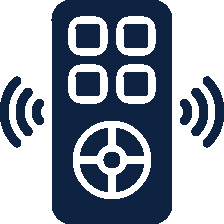
SMART CONTROLS
Control MaxForce screens via remote and
phone or integrate with popular home automation systems for advanced
capabilities.

SECURE TRACK
MaxForce Fix Hurricane Track holds firm under extreme loads

MAX CORROSION PROTECTION
Powder Coated Aluminum Protects your investment from exposer and corrosion.

HEAVY-DUTY DESIGN
Our screens are designed to withstand the extreme. High wind, Rain, or Shine, Dust Dirt, Dander, it doesn't matter. MaxForce Cover it all.

CUSTOM-MADE SCREENS
Tailor-made screens with vast color, fabric, and system options. Custom paint color and fabric matching are available.
MAXFORCE THE #1 MOTORIZED HURRICANE SCREEN
Contact A+ Certified MaxForce Screen Dealer Today...

HEADACHE-FREE
Exclusive self-tensioning system eliminates 99.9% of screen issues.
No track adjustments, broken zippers,
or dislodged screens.

LIFETIME WARRANTY
Exterior shade screens reduce cooling
bills and MaxForce hurricane screens
reduce insurance premiums in
hurricane zones.

HURRICANE STRONG
Our MaxForce tracks and advanced hybrid ballistic fabrics withstand
150+ mph winds. Approved by Florida Building Commission for hurricane
zones. Lab and real-world tested.

BUILT TO LAST
We use marine-grade materials such
as powder-coated aluminum, UV-protected nylons, stainless steel
fasteners, and premium fabrics. Resists corrosion, rust, and screen failure.

COST-SAVING
Exterior shade screens reduce cooling
bills and MaxForce hurricane screens
reduce insurance premiums in
hurricane zones.

SMART CONTROLS
Control MaxForce screens via remote and
phone or integrate with popular home automation systems for advanced
capabilities.

SECURE TRACK
MaxForce Fix Hurricane Track holds firm under extreme loads

MAX CORROSION PROTECTION
Powder Coated Aluminum Protects your investment from exposer and corrosion.

HEAVY-DUTY DESIGN
Our screens are designed to withstand
the extreme. High wind, Rain, or Shine,
Dust Dirt, Dander, it doesn't matter. MaxForce Cover it all.

CUSTOM-MADE SCREENS
Tailor-made screens with vast color, fabric, and system options. Custom
paint color and fabric matching are available.
MAXFORCE THE #1 MOTORIZED
HURRICANE SCREEN
Contact A+ Certified MaxForce Screen
Dealer Today...
MAXFORCE
Ready For Life's Storms

MAXFORCE HURRICANE SCREEN SYSTEM
A Certified, Tested System...
The MaxForce Hurricane Screen System meets or exceeds Miami-Dade and Florida Building Code requirements—the toughest hurricane codes on earth—for roll-down hurricane screens. Rated for the 185 MPH wind zone, and with real-world and certified testing. With spans of up to 25 feet, they exceed performance criteria for all local and International Building Codes.
MAXFORCE THE #1 MOTORIZED HURRICANE SCREEN
Contact A+ Certified MaxForce Screen Dealer Today...
MAXFORCE
Ready For Life's Storms

MAXFORCE HURRICANE SCREEN SYSTEM
A Certified, Tested System...
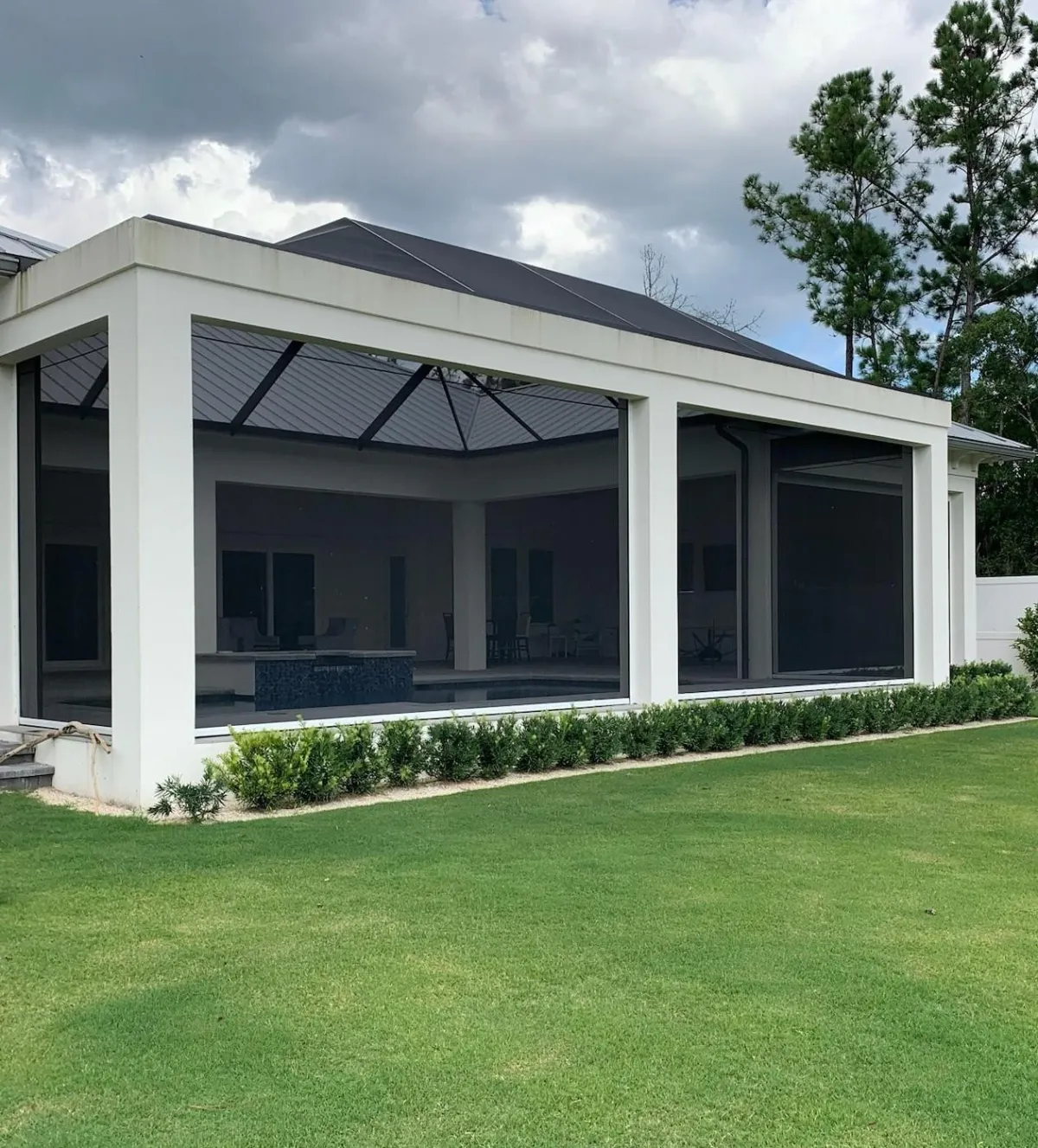
The MaxForce Hurricane Screen System meets or exceeds Miami-Dade and Florida Building Code requirements—the toughest hurricane codes on earth—for roll-down hurricane screens. Rated for the 185 MPH wind zone, and with real-world and certified testing. With spans of up to 25 feet, they exceed performance criteria for all local and International Building Codes.
MAXFORCE THE #1 MOTORIZED
HURRICANE SCREEN
Contact A+ Certified MaxForce Screen
Dealer Today...
THE MAXFORCE DIFFERENCE
Maxforce Hurricane Screen
THE MAXFORCE DIFFERENCE
MaxForce Hurricane Screen
MaxForce Hurricane Screens, powered by our MaxForce system, meet the toughest standards—including HVHZ certification in Miami-Dade and Broward. They last longer, resist more, and do more than any screen on the market—proven protection without compromise.
MaxForce Hurricane Screens —Delivers 365 days of perfect protection, rain or shine, on your patio and lanai. With the push of a button or a tap on the mobile app, your patio is storm-ready— furniture and openings fully protected in seconds.
MaxForce Hurricane Screens fabric blocks up to 95% of the sun’s damaging UV-rays while shielding against wind, rain, insects, dust, and debris. It also helps reduce heat and lower energy costs by limiting solar exposure—comfort and protection in one smart solution.
Like all Fenetex products, our MaxForce Hurricane Screens are highly customizable and built to order—made to fit your exact openings. No guesswork, no compromises—just precision-fit protection tailored to your space.
Pair our retractable MaxForce Hurricane Screens with other Fenetex screens for customized and independent solutions. Each screen operates independently, giving you the protection you want when you need it.
MaxForce Hurricane Screens offer built-in privacy without blocking your view. Like a two-way mirror, you can see out—but neighbors and passersby can not see in. It provides the perfect blend of openness and seclusion, day or night.
MAXFORCE THE #1 MOTORIZED HURRICANE SCREEN
Contact A+ Certified MaxForce Screen Dealer Today...
INTEGRITY MATTERS
How MaxForce Is Made Matters
MaxForce Hurricane Screens, powered by our MaxForce system, meet the toughest standards—including HVHZ certification in Miami-Dade and Broward. They last longer, resist more, and do more than any screen on the market—proven protection without compromise.
.
MaxForce Hurricane Screens —Delivers 365 days of perfect protection, rain or shine, on your patio and lanai. With the push of a button or a tap on the mobile app, your patio is storm-ready— furniture and openings fully protected in seconds.
MaxForce Hurricane Screens fabric blocks up to 95% of the sun’s damaging UV-rays while shielding against wind, rain, insects, dust, and debris. It also helps reduce heat and lower energy costs by limiting solar exposure—comfort and protection in one smart solution.
.
Like all Fenetex products, our MaxForce Hurricane Screens are highly customizable and built to order—made to fit your exact openings. No guesswork, no compromises—just precision-fit protection tailored to your space.
.
Pair our retractable MaxForce Hurricane Screens with other Fenetex screens for customized and independent solutions. Each screen operates independently, giving you the protection you want when you need it.
.
MaxForce Hurricane Screens offer built-in privacy without blocking your view. Like a two-way mirror, you can see out—but neighbors and passersby can not see in. It provides the perfect blend of openness and seclusion, day or night.
.
MAXFORCE THE #1 MOTORIZED
HURRICANE SCREEN
Contact A+ Certified MaxForce Screen
Dealer Today...
INTEGRITY MATTERS
How MaxForce Is
Made Matters
AMERICAN INGENUITY
Made in the USA.

Proudly Made in the USA—every MaxForce screen is built with American strength, precision, and pride. From the smallest components to the final assembly, our materials are sourced and manufactured right here in the United States. No outsourcing. No compromises. Just hardworking Americans protecting American homes with the toughest screen system on the market.

Category 3 Major Hurricane: 111-129 MPH Winds & Devastating Damage
This is where the designation changes.
Category 3. The National Hurricane Center calls it the threshold of "major hurricane" status. Wind speeds climb from 111 to 129 mph. Not just dangerous winds anymore. Devastating winds. The kind that don't just damage structures—they remove roof decking entirely, tear off gable ends, snap large trees like twigs, and turn neighborhoods into disaster zones.
Everything below Category 3 is preparation and protection. Everything at Category 3 and above is survival.
The word they use in the official definition isn't "extensive" or "significant." It's "devastating." That's not forecaster hyperbole. It's acknowledgment that at this threshold, hurricanes cross from destructive to fundamentally life-altering for entire communities.
When a Category 3 hurricane makes landfall, you don't bounce back in weeks. You measure recovery in months, sometimes years. Power doesn't return in days—it stays off for weeks as crews rebuild the grid from scratch. Water and electricity become luxuries, not utilities.
This is major hurricane territory. And nothing about it feels minor.
The Wind That Changes Everything
One hundred eleven miles per hour sustained winds. That's the minimum for Category 3.
At that speed, wind isn't weather. It's a physical force that reshapes landscapes. Trees that survived dozens of storms get snapped at mid-trunk or ripped from the ground entirely, their root systems exposed like torn veins. Not the weak trees. Not the diseased ones. The strong, mature hardwoods that defined neighborhoods for generations—gone in hours.
Well-built frame homes sustain major damage. Roof decking doesn't just lose shingles—it gets torn off completely. Gable ends collapse. Walls crack. The structural integrity of homes gets compromised in ways that require months of rebuilding, not just repairs.
Mobile homes? Completely destroyed. All of them. Newer ones, older ones, anchored or not—Category 3 winds don't discriminate. They flatten manufactured housing entirely.
Storm surge reaches nine to twelve feet above normal tide. That's enough to inundate first and second floors in coastal areas. Enough to turn beach roads into rivers. Enough to pick up vehicles and deposit them blocks away.
And the aftermath? Roads become impassable, blocked by thousands of downed trees. Power lines lay tangled in the wreckage. Utility poles snap and fall. Communication towers topple. The infrastructure that modern life depends on simply stops working.
When Numbers Tell Stories
August 2005. Hurricane Katrina churned across the Gulf of Mexico as a Category 5 monster with 175 mph winds. But by the time it made landfall near Buras-Triumph, Louisiana on August 29, it had weakened to Category 3 with 125 mph winds.
Category 3. Not the strongest on the scale. Not even close to the Category 5 power it had displayed over open water. Yet Katrina killed 1,392 people and caused $125 billion in damage, making it tied with Hurricane Harvey as the costliest tropical cyclone in Atlantic history.
The story everyone knows is the flooding of New Orleans—80% of the city underwater, levees catastrophically failing, people stranded on roofs for days. What gets lost is that Katrina's devastation extended far beyond the flood zones.
The wind alone caused massive destruction. In Mississippi, the storm surge exceeded twenty-six feet in some locations—nearly three stories high—slamming into Gulfport and Biloxi with apocalyptic force. Entire beachfront communities disappeared. Casinos built on barges broke free and smashed into bridges. The coastline was simply erased.
The hurricane knocked out power to millions. Not for days. For weeks. Some areas went a month without electricity in the brutal late-summer heat. Hospitals failed. Communication systems collapsed. The response became one of the most criticized disaster management efforts in American history.
More than a million people evacuated. Tens of thousands ended up in the Louisiana Superdome and convention center in conditions that shocked the nation. The economic impact rippled through the entire Gulf Coast for years.
Twenty years later, some neighborhoods in New Orleans still haven't fully recovered. The population dropped by more than half after the storm and has only partially returned. Category 3 didn't just damage these communities—it fundamentally changed them.
Or go back to August 1983. Hurricane Alicia—a small, compact Category 3 storm that most people outside Texas have forgotten. It made landfall on Galveston's west end with 115 mph winds in the early morning hours of August 18.
Alicia tracked directly over Houston, passing just west of downtown. The city's tall buildings created wind tunnel effects that amplified gusts to 127 mph. Those winds picked up gravel from roof insulation and air conditioning units, turning them into projectiles that smashed thousands of windows in the downtown skyscrapers.
Glass rained down on the streets. Buildings designed to withstand hurricane-force winds failed not from the wind itself but from the debris it carried. The shards became deadly missiles.
The storm caused $3 billion in damage—making it the costliest hurricane in U.S. history at that time—and killed twenty-one people. It spawned twenty-three tornadoes. Storm surge reached twelve feet along Galveston Bay. Tens of thousands of trees fell across the Houston area, aided by saturated soils from heavy rain in the weeks before the hurricane.
Alicia held the damage record for Texas hurricanes for decades, until Tropical Storm Allison and then Hurricane Ike surpassed it. But in 1983, it showed Texas what a relatively small Category 3 hurricane could do when it hit a rapidly growing metropolitan area.
Why Major Hurricane Status Matters
The designation isn't arbitrary. Category 3 represents a fundamental shift in what hurricanes can do and what protection looks like.
Below Category 3, you can reasonably expect well-built homes with proper protection to survive with repairable damage. Power outages last days, maybe a week or two. Communities recover relatively quickly.
At Category 3 and above, all bets are off. Even well-built structures sustain major damage. Power infrastructure doesn't just fail—it gets destroyed and must be rebuilt. Recovery takes months or years, not weeks. Some residents never return.
Storm surge becomes truly life-threatening. Nine to twelve feet is enough to flood entire coastal neighborhoods. Evacuation becomes mandatory, not optional. Staying behind becomes potentially fatal.
The tornado threat increases dramatically. Category 3 hurricanes spawn dozens of tornadoes in their outer bands, adding yet another layer of danger to an already catastrophic situation.
And the psychological impact changes. People who weather Category 1 or 2 storms might stay for the next one. People who survive Category 3 storms often leave and don't come back. The trauma runs deeper. The recovery feels impossible.
The Infrastructure Reality
Power restoration after Category 3 hurricanes isn't a matter of flipping switches or replacing a few transformers. Entire sections of the grid need rebuilding from the ground up. Poles replaced. Lines restrung. Substations repaired or rebuilt.
Crews come from across the country to help, but even with thousands of workers, the process takes weeks. Priority goes to hospitals, emergency services, water treatment facilities. Residential areas might wait three weeks or more.
No power means no air conditioning in late summer heat that can exceed 100 degrees. No refrigeration—food spoils within days. No way to charge phones or access information. Medical equipment stops working. People dependent on oxygen or dialysis face life-threatening situations.
Water systems fail when power fails. Even if water is available, boil water advisories last for weeks as treatment plants struggle to operate and contamination spreads through compromised pipes.
Roads stay impassable for days or weeks. The sheer volume of debris—trees, power lines, building materials, vehicles—makes clearing roads a monumental task. Emergency vehicles can't reach people who need help. Supply trucks can't deliver food and water.
Protection at This Threshold
Standard residential construction isn't enough for Category 3 storms. Not even close.
Windows become the weakest link. One broken window allows wind inside the structure, which creates pressure that can lift the roof off entirely. Hurricane-rated impact windows or properly installed hurricane screens become essential, not optional.
Roofs need reinforcement beyond standard building codes. Roof-to-wall connections must withstand uplift forces that standard construction wasn't designed to handle. Roof decking needs additional fasteners. Every weak point becomes a failure point at these wind speeds.
But here's the hard truth: even the best residential protection has limits. Category 3 storms can overwhelm any defense except purpose-built hurricane-resistant structures with concrete walls and impact-resistant everything.
For most people, protection at Category 3 means one thing: evacuation. Get out of the storm surge zone. Get away from mobile homes. Get inland to stronger structures. The best protection is distance.
What Devastating Actually Means
"Devastating damage" isn't a forecast term. It's a promise.
It means neighborhoods that look like war zones. It means homes with no roofs and no walls. It means streets buried under debris six feet deep. It means entire communities without power, water, or communication for weeks.
It means people living in damaged homes because shelters are full and there's nowhere else to go. It means children missing school for months. It means businesses that never reopen. It means generational homes lost forever.
It means National Guard troops distributing water and MREs weeks after the storm. It means FEMA trailers that become permanent housing. It means insurance battles that last years. It means communities that look different—feel different—forever.
Category 3 is where hurricanes stop being weather events you experience and start being disasters you survive. Or don't.
The Bottom Line
Major hurricane status at Category 3 isn't a bureaucratic distinction. It's a warning that the fundamental nature of the threat has changed.
Below Category 3, you're protecting property and dealing with extended inconvenience. At Category 3 and above, you're protecting life and facing potential catastrophe.
The winds are devastating—111 to 129 mph sustained, with gusts much higher. The damage is major—roof decking removed, gables collapsed, trees everywhere. The power loss is measured in weeks, not days. The recovery takes months, not weeks.
These storms require total commitment to preparation. Maximum protection measures. Honest assessment of vulnerability. And when evacuation orders come, they demand you leave.
Because Category 3 is where hurricanes prove they're more powerful than any preparation you can make. Where the difference between surviving and not surviving comes down to the decisions you make before the storm ever arrives.
This is major hurricane territory. The wind doesn't ask if you're ready. The surge doesn't wait for you to evacuate. The devastation doesn't care about your plans.
When Category 3 threatens your area, you have one job: take it seriously. More seriously than you've taken anything before. Because at this threshold, hurricanes aren't testing your preparedness.
They're testing your survival.
Next in the series: Category 4: Catastrophic Force
Previous post: Category 2: When Protection Becomes Critical
Additional Resources:
National Hurricane Center - Major Hurricanes - Official definition of Category 3+ storms
NOAA Hurricane Katrina - Comprehensive storm analysis
Ready.gov Hurricane Evacuation - Federal evacuation guidelines
Company
MaxForce Hurricane Screens
Design Ideals
Resources

© 2025 Maxforce - Powered by Fenetex and Friends of Oatis
AMERICAN INGENUITY
Made in the USA
Proudly Made in the USA—every MaxForce screen is built with American strength, precision, and pride. From the smallest components to the final assembly, our materials are sourced and manufactured right here in the United States. No outsourcing. No compromises. Just hardworking Americans protecting American homes with the toughest screen system on the market.

Category 3 Major Hurricane: 111-129 MPH Winds & Devastating Damage
This is where the designation changes.
Category 3. The National Hurricane Center calls it the threshold of "major hurricane" status. Wind speeds climb from 111 to 129 mph. Not just dangerous winds anymore. Devastating winds. The kind that don't just damage structures—they remove roof decking entirely, tear off gable ends, snap large trees like twigs, and turn neighborhoods into disaster zones.
Everything below Category 3 is preparation and protection. Everything at Category 3 and above is survival.
The word they use in the official definition isn't "extensive" or "significant." It's "devastating." That's not forecaster hyperbole. It's acknowledgment that at this threshold, hurricanes cross from destructive to fundamentally life-altering for entire communities.
When a Category 3 hurricane makes landfall, you don't bounce back in weeks. You measure recovery in months, sometimes years. Power doesn't return in days—it stays off for weeks as crews rebuild the grid from scratch. Water and electricity become luxuries, not utilities.
This is major hurricane territory. And nothing about it feels minor.
The Wind That Changes Everything
One hundred eleven miles per hour sustained winds. That's the minimum for Category 3.
At that speed, wind isn't weather. It's a physical force that reshapes landscapes. Trees that survived dozens of storms get snapped at mid-trunk or ripped from the ground entirely, their root systems exposed like torn veins. Not the weak trees. Not the diseased ones. The strong, mature hardwoods that defined neighborhoods for generations—gone in hours.
Well-built frame homes sustain major damage. Roof decking doesn't just lose shingles—it gets torn off completely. Gable ends collapse. Walls crack. The structural integrity of homes gets compromised in ways that require months of rebuilding, not just repairs.
Mobile homes? Completely destroyed. All of them. Newer ones, older ones, anchored or not—Category 3 winds don't discriminate. They flatten manufactured housing entirely.
Storm surge reaches nine to twelve feet above normal tide. That's enough to inundate first and second floors in coastal areas. Enough to turn beach roads into rivers. Enough to pick up vehicles and deposit them blocks away.
And the aftermath? Roads become impassable, blocked by thousands of downed trees. Power lines lay tangled in the wreckage. Utility poles snap and fall. Communication towers topple. The infrastructure that modern life depends on simply stops working.
When Numbers Tell Stories
August 2005. Hurricane Katrina churned across the Gulf of Mexico as a Category 5 monster with 175 mph winds. But by the time it made landfall near Buras-Triumph, Louisiana on August 29, it had weakened to Category 3 with 125 mph winds.
Category 3. Not the strongest on the scale. Not even close to the Category 5 power it had displayed over open water. Yet Katrina killed 1,392 people and caused $125 billion in damage, making it tied with Hurricane Harvey as the costliest tropical cyclone in Atlantic history.
The story everyone knows is the flooding of New Orleans—80% of the city underwater, levees catastrophically failing, people stranded on roofs for days. What gets lost is that Katrina's devastation extended far beyond the flood zones.
The wind alone caused massive destruction. In Mississippi, the storm surge exceeded twenty-six feet in some locations—nearly three stories high—slamming into Gulfport and Biloxi with apocalyptic force. Entire beachfront communities disappeared. Casinos built on barges broke free and smashed into bridges. The coastline was simply erased.
The hurricane knocked out power to millions. Not for days. For weeks. Some areas went a month without electricity in the brutal late-summer heat. Hospitals failed. Communication systems collapsed. The response became one of the most criticized disaster management efforts in American history.
More than a million people evacuated. Tens of thousands ended up in the Louisiana Superdome and convention center in conditions that shocked the nation. The economic impact rippled through the entire Gulf Coast for years.
Twenty years later, some neighborhoods in New Orleans still haven't fully recovered. The population dropped by more than half after the storm and has only partially returned. Category 3 didn't just damage these communities—it fundamentally changed them.
Or go back to August 1983. Hurricane Alicia—a small, compact Category 3 storm that most people outside Texas have forgotten. It made landfall on Galveston's west end with 115 mph winds in the early morning hours of August 18.
Alicia tracked directly over Houston, passing just west of downtown. The city's tall buildings created wind tunnel effects that amplified gusts to 127 mph. Those winds picked up gravel from roof insulation and air conditioning units, turning them into projectiles that smashed thousands of windows in the downtown skyscrapers.
Glass rained down on the streets. Buildings designed to withstand hurricane-force winds failed not from the wind itself but from the debris it carried. The shards became deadly missiles.
The storm caused $3 billion in damage—making it the costliest hurricane in U.S. history at that time—and killed twenty-one people. It spawned twenty-three tornadoes. Storm surge reached twelve feet along Galveston Bay. Tens of thousands of trees fell across the Houston area, aided by saturated soils from heavy rain in the weeks before the hurricane.
Alicia held the damage record for Texas hurricanes for decades, until Tropical Storm Allison and then Hurricane Ike surpassed it. But in 1983, it showed Texas what a relatively small Category 3 hurricane could do when it hit a rapidly growing metropolitan area.
Why Major Hurricane Status Matters
The designation isn't arbitrary. Category 3 represents a fundamental shift in what hurricanes can do and what protection looks like.
Below Category 3, you can reasonably expect well-built homes with proper protection to survive with repairable damage. Power outages last days, maybe a week or two. Communities recover relatively quickly.
At Category 3 and above, all bets are off. Even well-built structures sustain major damage. Power infrastructure doesn't just fail—it gets destroyed and must be rebuilt. Recovery takes months or years, not weeks. Some residents never return.
Storm surge becomes truly life-threatening. Nine to twelve feet is enough to flood entire coastal neighborhoods. Evacuation becomes mandatory, not optional. Staying behind becomes potentially fatal.
The tornado threat increases dramatically. Category 3 hurricanes spawn dozens of tornadoes in their outer bands, adding yet another layer of danger to an already catastrophic situation.
And the psychological impact changes. People who weather Category 1 or 2 storms might stay for the next one. People who survive Category 3 storms often leave and don't come back. The trauma runs deeper. The recovery feels impossible.
The Infrastructure Reality
Power restoration after Category 3 hurricanes isn't a matter of flipping switches or replacing a few transformers. Entire sections of the grid need rebuilding from the ground up. Poles replaced. Lines restrung. Substations repaired or rebuilt.
Crews come from across the country to help, but even with thousands of workers, the process takes weeks. Priority goes to hospitals, emergency services, water treatment facilities. Residential areas might wait three weeks or more.
No power means no air conditioning in late summer heat that can exceed 100 degrees. No refrigeration—food spoils within days. No way to charge phones or access information. Medical equipment stops working. People dependent on oxygen or dialysis face life-threatening situations.
Water systems fail when power fails. Even if water is available, boil water advisories last for weeks as treatment plants struggle to operate and contamination spreads through compromised pipes.
Roads stay impassable for days or weeks. The sheer volume of debris—trees, power lines, building materials, vehicles—makes clearing roads a monumental task. Emergency vehicles can't reach people who need help. Supply trucks can't deliver food and water.
Protection at This Threshold
Standard residential construction isn't enough for Category 3 storms. Not even close.
Windows become the weakest link. One broken window allows wind inside the structure, which creates pressure that can lift the roof off entirely. Hurricane-rated impact windows or properly installed hurricane screens become essential, not optional.
Roofs need reinforcement beyond standard building codes. Roof-to-wall connections must withstand uplift forces that standard construction wasn't designed to handle. Roof decking needs additional fasteners. Every weak point becomes a failure point at these wind speeds.
But here's the hard truth: even the best residential protection has limits. Category 3 storms can overwhelm any defense except purpose-built hurricane-resistant structures with concrete walls and impact-resistant everything.
For most people, protection at Category 3 means one thing: evacuation. Get out of the storm surge zone. Get away from mobile homes. Get inland to stronger structures. The best protection is distance.
What Devastating Actually Means
"Devastating damage" isn't a forecast term. It's a promise.
It means neighborhoods that look like war zones. It means homes with no roofs and no walls. It means streets buried under debris six feet deep. It means entire communities without power, water, or communication for weeks.
It means people living in damaged homes because shelters are full and there's nowhere else to go. It means children missing school for months. It means businesses that never reopen. It means generational homes lost forever.
It means National Guard troops distributing water and MREs weeks after the storm. It means FEMA trailers that become permanent housing. It means insurance battles that last years. It means communities that look different—feel different—forever.
Category 3 is where hurricanes stop being weather events you experience and start being disasters you survive. Or don't.
The Bottom Line
Major hurricane status at Category 3 isn't a bureaucratic distinction. It's a warning that the fundamental nature of the threat has changed.
Below Category 3, you're protecting property and dealing with extended inconvenience. At Category 3 and above, you're protecting life and facing potential catastrophe.
The winds are devastating—111 to 129 mph sustained, with gusts much higher. The damage is major—roof decking removed, gables collapsed, trees everywhere. The power loss is measured in weeks, not days. The recovery takes months, not weeks.
These storms require total commitment to preparation. Maximum protection measures. Honest assessment of vulnerability. And when evacuation orders come, they demand you leave.
Because Category 3 is where hurricanes prove they're more powerful than any preparation you can make. Where the difference between surviving and not surviving comes down to the decisions you make before the storm ever arrives.
This is major hurricane territory. The wind doesn't ask if you're ready. The surge doesn't wait for you to evacuate. The devastation doesn't care about your plans.
When Category 3 threatens your area, you have one job: take it seriously. More seriously than you've taken anything before. Because at this threshold, hurricanes aren't testing your preparedness.
They're testing your survival.
Next in the series: Category 4: Catastrophic Force
Previous post: Category 2: When Protection Becomes Critical
Additional Resources:
National Hurricane Center - Major Hurricanes - Official definition of Category 3+ storms
NOAA Hurricane Katrina - Comprehensive storm analysis
Ready.gov Hurricane Evacuation - Federal evacuation guidelines
Company
MaxForce Hurricane Screens
Design Ideals
Resources

© 2025 Maxforce - Powered by Fenetex and Friends of Oatis

